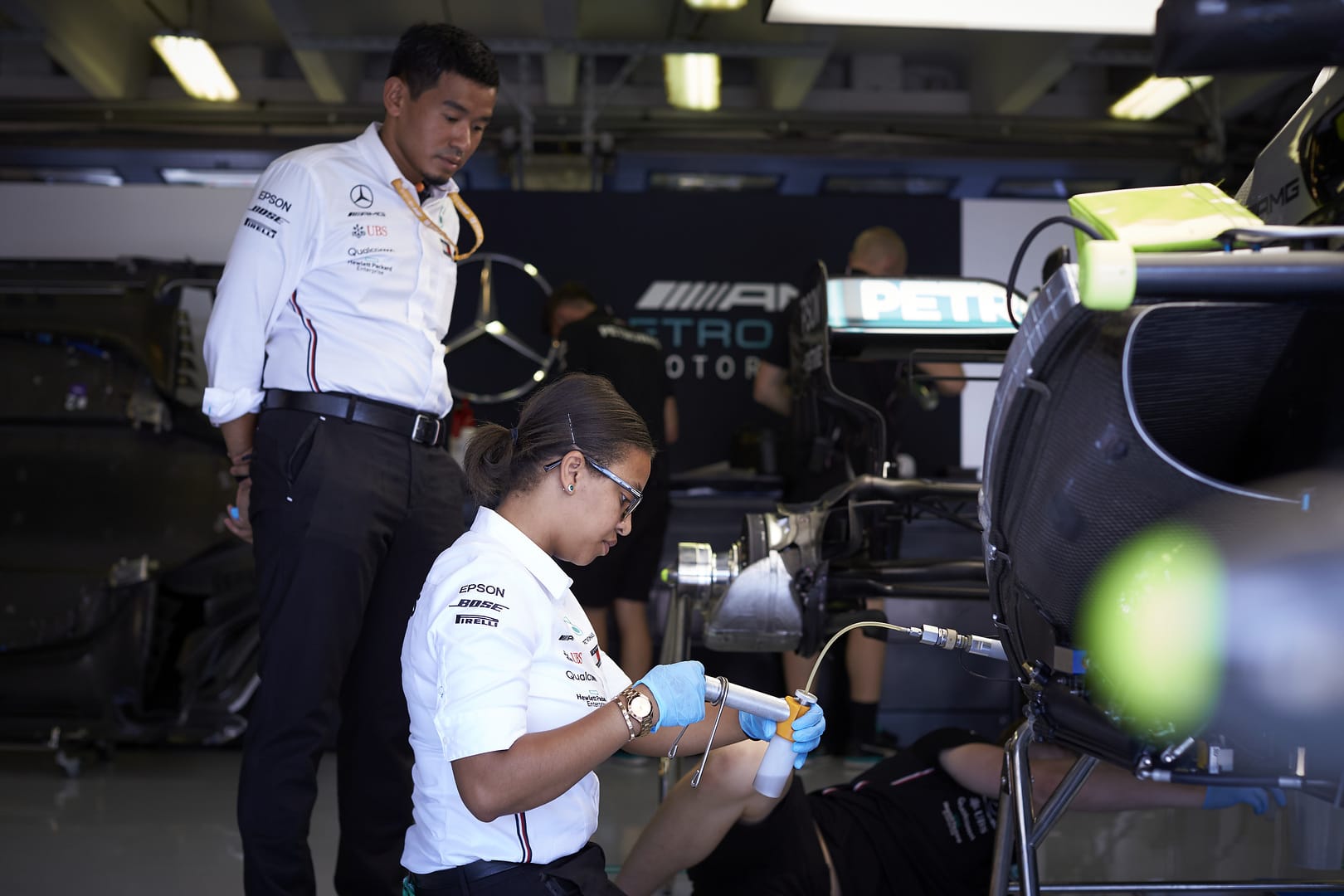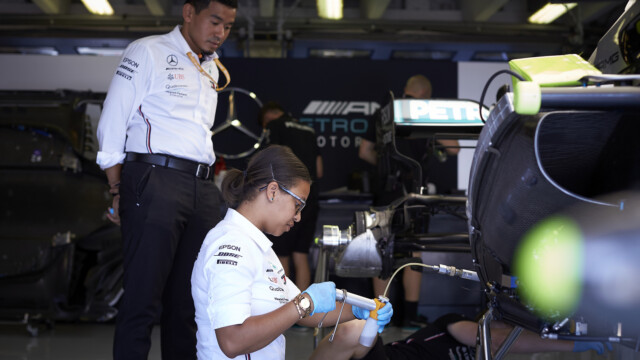What Oil Do F1 Cars Use?


Have you ever wondered, what oil do F1 cars use? Fully synthetic oil is used in F1 engines, which can function at temperatures of up to 300 degrees Celsius. Each GP weekend, each team receives different FIA-legal oils from their lubricant partner. Teams test several oils at each GP to see which works best for the local weather.
Let’s examine in more detail the various engine oils that F1 vehicles use and how these might be changed to improve performance across a race weekend, as understanding car performance is a key component of betting on F1.
What Oil Is Used In F1 Cars?
No two F1 teams have the same oil in their cars since different F1 teams have different oil or lubricant partners. F1 teams will be able to use the highest quality synthetic base stock of high-performance racing oil that each oil business has to offer before blending a variety of oils specifically for the team.
Fully synthetic base stocks are required for high-performance racing oils, such as those used by F1 teams, as these are the only ones for which the oil producer can provide the necessary consistency in temperature resistance and performance. Fully synthetic base stock can also be molecularly created to meet the various requirements of the F1 team.
Each oil producer has a molecular engineering research and development team that collaborates closely with the F1 team to continuously adjust the synthetic base stock to chemical additive ratio to personalize the oil for peak performance. Because the air pressure and temperature at the F1 racing tracks change during the season, it is typical to have engine oil specially formulated for each circuit’s particular characteristics.
One of the parts of the sport that was historically least controlled was the engine oils used in F1 cars. The FIA limited the amount of engine oil that could be burned during a race in 2018, which brought about a change. The FIA also made it clearer what constituted F1 engine oil, defining it as “a material that must be readily recognizable as a lubricant.”
What Grade Of Oil Is Used In F1 Cars?
The most popular Group IV full-synthetic PAO base oil blend with a 10W-60 viscosity rating is the source of the base stock for F1 cars.
The HTHS (High Temperature/High Shear) viscosity requirement of higher than 3.7 mPas is necessary since F1 engines operate at 15000 rpm and 300 °C. This is greater than “typical” racing oil, which has a minimum pressure of 3.5 mPas.
If the viscosity of the engine oil is too low, there won’t be enough defence against wear. This is important since each car can only replace a power unit so many times in the current period.
Additionally, engine oil with low viscosity will carbonise (burn-off) more quickly. Teams cannot afford for their engine oil to burn off too quickly since the FIA has set the maximum oil consumption threshold of any power unit at 1.2 litres per 100 kilometres.
What Is Special About F1 Engine Oil?
An F1 engine runs at far higher temperatures and pressures while rotating at a rate of 15,000 rpm. For teams to get the most racing weekends out of each power unit, the engine oil they use needs to be able to handle these circumstances and provide maximum protection against wear.
Teams accomplish this by adding chemicals to the base stock of their entirely synthetic high-performance oil. Each squad jealously controls its own secret additive ratio. The kinds of additives each team can use are listed in the table below, along with descriptions of what each addition does.
| Additive | Function |
| Viscosity Index Improvers | Increase resistance to heat and harsh circumstances |
| Pour Point Depressants | Lower oil freezing point when it’s cold |
| Anti-wear Additives | Protect against metal-to-metal contact |
| Detergents & Dispersants | Maintaining cleanliness and avoiding sludging |
| Oxidation Inhibitors | Maintain oil stability throughout service intervals |
| Corrosion & Rust Inhibitors | Protect against condensation’s negative effects |
| Defoamants | Avoid cavitations and oil foaming |
How Much Oil Is Used in F1 Cars?
During a race, Formula 1 vehicles can need up to 5 litres of oil. The FIA caps the flow of fuel at 100kg per hour. Any oil that is consumed in the engine is consequently added fuel, which raises the engine’s power output.
Teams pay strict attention to how much oil an F1 car consumes. A surplus of oil at the finish line may add nearly a kilogram of weight over the potentially crucial last five circuits. A power unit that has insufficient oil could fail and not reach the finish line. To finish first, you must first complete.
The FIA has set a limit on the oil usage of any power unit at no more than 1.2 litres per 100km to make things more difficult for teams. That equals 60ml each lap. These restrictions were cut in half for the 2018 season, at 0.6 litres per 100 kilometres, or around 30 ml per lap. There are still restrictions on how much oil may be consumed.
Teams must modify their oil viscosity from race to race due to the cap put on the consumption rate and the necessity to guarantee there is enough oil left over at the end of the Grand Prix. A race’s starting weight will increase if the viscosity is too high, while a low viscosity will result in more consumption and a larger risk of violating the FIA’s oil consumption regulations.
Does Thicker Oil Work Better For F1 Racing?
The 15000 rpm engines of F1 cars spin at extreme temperatures. Any oil will grow thinner as it warms up. The oil used in Formula One car engines must be thicker so that as it heats up, it will still be able to adequately coat all of the engine parts.
Since F1 engines are dry-sump engines, there is no oil sump sloshing about under the engine while the car turns at a high rate of speed. F1 cars include an exterior oil tank that supplies oil to the engine and other components, improving the car’s balance when travelling at high speeds.
If the oil of an F1 car is somewhat thinner, it can be burned in the engine as extra fuel to provide more power. This is a practical strategy for qualifying because a little extra power can go a long way. For the actual race, teams can switch to heavier oil. For qualifying, the auxiliary oil tank must be empty; however, for the race, it is full, making it simple to add thicker oil to the lubrication system.
How Much Oil Can An F1 Engine Hold?
The two oil capacity or volume limiting considerations listed in the FIA regulations are
- The first is the 0.6 litres of oil consumed per 100 kilometres of racing. To control this, “FIA must always be provided with the measurement of the oil level in the main oil tank. The oil tank that is directly attached to the engine oil feed at the oil pressure pump’s input is known as the main oil tank (Section 5.24.3 of the 2022 FIA regulations).
- The second limitation relates to the largest possible size of the auxiliary oil tank (AOT). “The AOT’s combined volume, including its connections to the engine, cannot exceed 2.5 litres. A solenoid is required to manage the flow of oil between the AOT and the engine (Section 5.24.5 of the 2022 FIA regulations). By pressing the “oil” button on the F1 steering wheel, the solenoid is turned on.
How Frequently Do F1 Cars Change Their Oil?
Other than the fact that cars cannot change or top up their oil in the pits during a race, there is nothing in the FIA regulations that restricts the number of times a team can change the oil in an F1 car during a race weekend.
Each team has a variety of engine oils available for use each race weekend, as I previously said. However, before they can be used in competition, each of those readily available oils must first undergo testing and receive official authorization from the FIA. (Section 16.10.2 of the FIA rules for 2022)
Teams use free practice to test various engine oils in a racing-like setting before deciding which engine oil each driver will use for qualifying and the race. The FIA must be notified once the team has decided which oil it will use during the race. “Each Competitor shall disclose, in writing, the type of oil to be used in each of his or her engines throughout each Competition”. (Section 16.11.1 of the 2022 FIA regulations)
Because of this, it is possible that each run a car does during the first free practice session and, in some situations, the second session, will be done with a different engine oil combination. That is a lot of oil changes in a short period of time.
As you might expect, changing engine oil so frequently over the course of a Grand Prix weekend will inevitably result in a little amount of one engine oil’s residue mingling with the next oil to be tested. The FIA acknowledged this as well and changed the rules governing the technical inspectors’ engine oil testing after each Grand Prix.
The chemical composition of the oil is known as the “reference engine oil” that samples taken from each car after each race can be compared to when a team submits oil to the FIA for approval. “Samples that deviate from the reference engine oil in a way consistent with the mixing with other engine oils, which have been approved by the FIA for use by the team at a Competition, will be deemed to comply, provided that the adulterant oils are overall present at no more than 10% in the sample,” states the FIA. (Section 16.11.3 of the 2022 FIA regulations)
Which Oil Is Used By Each F1 Team?
Each team on the F1 grid has an official lubricant partner that collaborates with team engineers to provide a variety of engine lubricants best suited to that team’s engines’ characteristics at various ambient temperatures.
| Team | Lubricant Partner |
| Red Bull Racing | Mobil 1 |
| Ferrari | Shell |
| Mercedes | Petronas |
| Alpine | BP and Castrol |
| McLaren | Gulf Oil |
| Alfa Romeo | Petronas |
| Haas F1 Team | Mobil 1 |
| AlphaTauri | Exxon Mobil oil |
| Aston Martin | Mobil 1 |
| Williams | Castrol |





